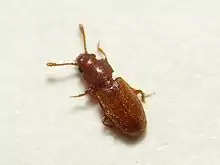Foreign grain beetle
The foreign grain beetle (Ahasverus advena) is a species of beetle in the family Silvanidae. It is related to the sawtoothed grain beetle.
| Foreign grain beetle | |
|---|---|
 | |
| Scientific classification | |
| Kingdom: | Animalia |
| Phylum: | Arthropoda |
| Class: | Insecta |
| Order: | Coleoptera |
| Family: | Silvanidae |
| Genus: | Ahasverus |
| Species: | A. advena |
| Binomial name | |
| Ahasverus advena (Waltl, 1832) | |
Description
The foreign grain beetle is approximately 2 mm (1⁄12 in) in length. It can be distinguished chiefly by slight projections or knobs on each front corner of the pronotum, and its club-shaped antennae. The larvae are worm-like, cream-colored and often reach a length of 3 mm before pupating into darker adults. Males and females are identical in appearance both as larvae and adults. The adult is usually reddish brown, or sometimes black.
Natural history
Distribution
The foreign grain beetle is found in tropical and temperate regions. It can complete development at temperatures between 20 and 35 °C.
Behavior
The beetle can only survive if relative humidity exceeds 70%, so it emerges in higher-humidity conditions. Its diet is entirely fungi. It can often be found in grain storage facilities, where it feeds on the mold growing on the grain. It can be found in other moist locations such as the walls of houses around plumbing systems.
Life cycle
The adult female can begin laying eggs around 3 to 4 days after emerging from the pupa. It can lay up to 8 or 12 eggs per day, but generally produces 1 to 4. Eggs are laid singly or in clusters of two or three, and they hatch in 4 to 5 days. The larval stage is completed in 11 to 19 days, and pupation takes 3 to 5 days. Larval development takes longer in drier conditions. Mated males have an average life span of 159 days, and mated females live about 208 days. Unmated beetles live longer, males up to 275 days, and females up to 300.
Impact on humans
The beetle is harmless. It may inhabit dwellings and infest products such as grains, cereals, oilseeds, dried fruit, and spices, particularly if the product is moldy. The presence of the beetle is a good indicator of damp storage conditions and spoiled food.[1] It does not damage the food itself, or any structures.
Control
The beetle is controlled by eliminating damp habitat. Insecticides may be used but must be applied frequently and it does not reach beetles inside grain kernels.[1] Diatomacous earth has also been used.
Biological control
Various insect predators and parasitic wasps attack this beetle. They are only effective in large numbers. They are rarely used in the United States because live insect biological pest control agents are not permitted in stores of in raw grain.[1]
References
- Weaver, D. 2004. Foreign Grain Beetle - Stored Grain. High Plains IPM Guide. University of Wyoming, University of Nebraska, Colorado State University, and Montana State University.
External links
- Foreign Grain Beetles. University of Minnesota, Yard & Garden Brief
- Foreign Grain Beetle. University of Kentucky College of Agriculture
- Foreign Grain Beetle. PestWeb, Government of Australia
- Foreign Grain Beetle. Canadian Grain Commission
- Foreign Grain Beetle. Iowa State University, Department of Entomology
- Bousquet, Y. (1990). "Beetles associated with stored products in Canada. An identification guide" (PDF). Canadian Government Publishing Centre Supply and Services Canada. Archived from the original (PDF) on 2011-04-10. Retrieved 2009-02-04.